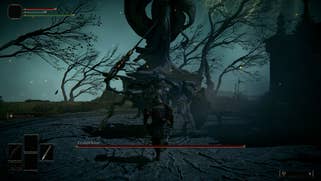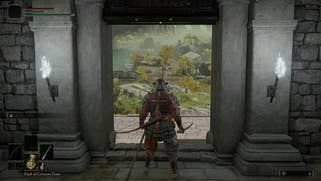The Elden Ring tech report: PS5 and Xbox Series consoles tested
Are there any improvements in graphics or performance since the beta?
In a sense, the core takeaways have not changed since we first looked at the Elden Ring network test last year. First of all, the quality of the game is beyond doubt - From Software deftly blending its unique Souls formula with an open-world to surprising success. Every inch of its map is ripe for exploration, rewarding players for going off the beaten path - for making discoveries at their own pace. However, in terms of technology, while there are changes to how the game presents on PlayStation 5 and Xbox Series consoles, the basic headlines remain in place. Whichever way you play, it's a challenge to get a stable 60fps level of performance on even new consoles, despite a choice of two rendering modes.
In summary, both quality and performance options run with a fully unlocked frame-rate. Kicking off with the quality mode, PS5 and Series X run at a fixed 4K - 3840x2160 - while Series S renders at 2560x1440. There's no dynamic resolution scaling in quality mode, meaning that performance adjusts constantly in order to keep resolutions rigidly fixed at these targets. DRS is possible though: it's integrated into the alternative frame-rate mode for every current-gen console.
On the PS5 and Series X this changes image quality, where the range varies from 2688x1512 at lowest to full 4K at peak. Series S is similar, albeit with a 1792x1008 to 2560x1440 dynamic range. It's worth noting that cutscenes are fixed to the max resolution in both cases. So, for example, PS5 and Series X run at a fixed 4K while first meeting Margit the Fell - even in frame-rate mode. Hence, the performance isn't wildly different to quality mode.
What's the difference? Curiously, if we factor out resolution, it's surprising to see just how close the two modes are in settings. Grass draw distance and density are identical between all consoles, and all modes. Even Series S holds its own against PS5 and Series X in rendering Limgrave's beautiful opening vistas. Shadow rendering however is the one big difference between the modes, with an improved turn-out in the quality mode. In Series S's case shadows are always one preset lower than PS5 and Series X equivalents (which in turn share the same setting regardless of mode), resulting in an especially blurry, low resolution shadow in its frame-rate mode.
Ultimately, it's hard to recommend the quality mode owing to its uneven performance and in our opinion, it's best avoided. It's clear none of the current-gen consoles work well in targeting a fixed, high resolution: the result being a wavering 30-60fps range for all three machines, occasionally dropping into the 20s. Typically, PlayStation 5 offers a lead over Series X in quality mode, while Series S languishes behind the three with the worst frame-rate reading. A fixed 30fps cap with consistent frame-pacing would have made this mode worth a look, in fairness, but based on last-gen consoles tests, it seems that From Software's 30fps implementation is still lacklustre and frame-pacing problems remain.
But what of the 60fps dream? One of the bigger surprises of the network test was that running the PlayStation 4 Pro version of the game on PS5 yielded a far more consistent frame-rate than using the the native PS5 app - and sadly, that remains the case. 60fps remains unattainable on the actual PS5 game, which ranges from 45-60fps in its frame-rate mode, occasionally dropping still further in effects-heavy scenes. It places PlayStation owners in a difficult spot: using PS4 Pro code means that the dynamic 4K on PS5 changes to checkerboarded 1800p, while grass draw distance takes a hit. You're effectively trading performance stability against image quality and visual features.
Series X is in much the same boat - the difference being that while running the Xbox One X version is technically possible on the new console, realistically it is not recommended as this process locks you out of patch updates and online features. Microsoft's system-level integration of variable refresh rate (VRR) support at least resolves this issue - if it's an option for you, we recommend setting your screen to 60Hz (even if it supports 120Hz) and using VRR here to smooth out the performance drops. All told, this is our preferred way to play the game across any available system - though in non-VRR mode, PlayStation 5 does actually run better. Typically, while traversing on foot, there's a margin of around 10fps in PS5's favour - though on horseback Series X can at points take a lead of its own. It's a mixed bag, but PS5 does have an advantage in frame-rate mode overall. Still, without VRR support, the v-sync judder is present either way.



























Where does this leave Xbox Series S? Again, frame-rate mode struggles with consistency and we'd also recommend variable refresh rate support in this case. The issue is that it's less effective overall, given that the average frame-rate is significantly lower. There comes a point where VRR loses its 'cure-all' properties in mitigating less-than-ideal performance and Elden Ring on Series S dances around that line.
Loading times see some difference between the systems, and it's generally in favour of PlayStation 5: a six to seven second wait for fast travel on Sony's machine compares well next to the 17 seconds on Xbox Series consoles. It's a significant difference, especially for a game that demands fast travel and often pushes players to rely on respawning. From Software is known for improving loading speeds in patches though (as we saw in Bloodborne), so hopefully Xbox sees some improvement.
There are other changes and bug-fixes we'd like to see too, but thankfully they are relatively minor gripes that need addressing. For example, motion blur is enabled in the game's quality mode. Oddly though, there is something unusual going on in the frame-rate mode. Especially on PS5 and Series X, motion blur switches on and off at different points; it enables itself in the opening boss fight against the Grafted Scion boss for example, and also Margit the Fell. It appears during boss fights, and then de-activates for open-world areas. By comparison Series S rarely has the effect engaged in frame-rate mode, if ever. It's very unusual - but much like the beta, it's clear PS5 typically has the effect engaged more often than Series X. So, in other words little has changed.












If the takeaway is that little has changed since the network test, it's interesting to note that there are some differences if we stack up PS5's final patch 1.02 vs the earlier beta. In quality and frame-rate modes, for example, frame-rates are actually lower than the network test, which runs 2-5fps faster in the older build. The advantage widens further in select cutscenes, showing something of a regression from the 60fps target here.
Also noticeable is that shadow draw distance is reined in for the final game, meaning emerging to Limgrave's open fields, trees are not longer shaded at a far range. This won't be noticeable outside of comparison, but it shows From Software has attempted to optimise the game's settings on console. Shadows consistently draw in farther afield, and yet the frame-rate is sadly not improved as a result of the drop. One explanation for the overall frame-rate decrease is that the network test only presented a portion of the world - with areas partitioned off, still in development. Either way it's clear visuals and frame-rates are changed for the worse here, if by small margins. Elsewhere, the overall impression is that little has changed for the better.
It's a shame to not see significant progress on the beta and the same drawbacks remain on a technical level. Elden Ring is clearly a fantastic work, perhaps From Software's finest iteration on its uniquely punishing game design and so, for many, the points raised in this piece won't matter. The game is so richly detailed, its art design so meticulously realised, that the frame-rate issues are overshadowed by the core experience of playing it. For PC users the game's optimisation is much more of a distraction - where consoles don't see the same degree of stuttering. It's a shame though that PS5 and Series X are clearly capable of running better and perhaps a good start would be a true '60fps mode', even if it relies on PS4 Pro or One X settings. The lack of movement from the network test suggests that performance isn't a priority for From Software - but we'd love to see an update that proves that this isn't the case.





.png?width=291&height=164&fit=crop&quality=80&format=jpg&auto=webp)

_MEGHzTK.png?width=291&height=164&fit=crop&quality=80&format=jpg&auto=webp)
.png?width=291&height=164&fit=crop&quality=80&format=jpg&auto=webp)

-Teaser-Trailer-(Directors-Cut)-_-Short-Film-2025-0-24-screenshot.png?width=291&height=164&fit=crop&quality=80&format=jpg&auto=webp)